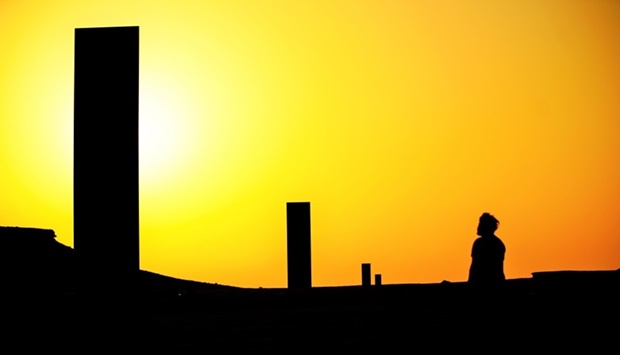Internationally acclaimed artist Richard Serra's East-West/West-East sculpture, a Qatar Museums (QM) project, is a creation like no other.
This breathtaking sculpture in the Brouq nature reserve spans over a kilometre and comprises four steel plates, each over 14m in height. A famous landmark in Qatar since its installation in 2014, the unique artwork out in the open desert is best visited during winter, given its location.

It may be recalled that to guarantee perfect alignment, Serra examined the topography of the land and beautifully enhanced the vast, desolate space in the heart of the desert. The result is spectacular and although contemporary, is timeless. The set of four standing steel plates were rolled in Germany, shipped via Antwerp, and offloaded, trucked, and craned into the location. It’s his second public commission in Qatar — the first, a towering sculpture titled “7,” in the Museum of Islamic Art Park, is his tallest ever.

Three of the four steel plates silhouetted against the evening sky, with some visitors and a SUV give an idea of the scale of the artwork.
The steel in both artworks will oxidise in the same way. Over the years, they have gone from gray to orange to brown, and are on their way to a dark amber, as Sierra has conceptualised.

It is understood that two of the East-West/West-East plates stand 14.7m high and the others rise 16.7m above the ground. Still, because they are adjusted for the topography, they are all level with each other.

As an art critic once wrote, during the hot temperatures of the summer, the pillars can absorb enough heat to cook scrambled eggs or even bake cookies. They are usually too hot to be touched.

The pillars are breathtaking, erected to form a straight corridor between the rundown cliffs synonymous with the topography of the region. After a bout of vandalism and extensive restoration efforts, QM has posted warning signs on the way to the sculpture.

East-West/West-East can be reached with a one hour drive from the Qatari capital, Doha, and not very far from The Cuban Hospital at Dukhan. No roads lead to the location, no signs and no maps. The only thing that visitors can rely on is the GPS co-ordinates that reads N250 31.019’E050o51.948′. The four monuments are located between the gypsum cliffs of the Brouq Nature Reserve.
This breathtaking sculpture in the Brouq nature reserve spans over a kilometre and comprises four steel plates, each over 14m in height. A famous landmark in Qatar since its installation in 2014, the unique artwork out in the open desert is best visited during winter, given its location.

The four monuments are located between the gypsum cliffs of the Brouq Nature Reserve.
It may be recalled that to guarantee perfect alignment, Serra examined the topography of the land and beautifully enhanced the vast, desolate space in the heart of the desert. The result is spectacular and although contemporary, is timeless. The set of four standing steel plates were rolled in Germany, shipped via Antwerp, and offloaded, trucked, and craned into the location. It’s his second public commission in Qatar — the first, a towering sculpture titled “7,” in the Museum of Islamic Art Park, is his tallest ever.

Three of the four steel plates silhouetted against the evening sky, with some visitors and a SUV give an idea of the scale of the artwork.
The steel in both artworks will oxidise in the same way. Over the years, they have gone from gray to orange to brown, and are on their way to a dark amber, as Sierra has conceptualised.

It is understood that two of the East-West/West-East plates stand 14.7m high and the others rise 16.7m above the ground. Still, because they are adjusted for the topography, they are all level with each other.

Each of the four steel plates are thicker than an average adult's palm.
As an art critic once wrote, during the hot temperatures of the summer, the pillars can absorb enough heat to cook scrambled eggs or even bake cookies. They are usually too hot to be touched.

A side view of one of the steel plates of the East-West/West-East sculpture, as seen from ground level.
The pillars are breathtaking, erected to form a straight corridor between the rundown cliffs synonymous with the topography of the region. After a bout of vandalism and extensive restoration efforts, QM has posted warning signs on the way to the sculpture.

East-West/West-East can be reached with a one hour drive from the Qatari capital, Doha, and not very far from The Cuban Hospital at Dukhan. No roads lead to the location, no signs and no maps. The only thing that visitors can rely on is the GPS co-ordinates that reads N250 31.019’E050o51.948′. The four monuments are located between the gypsum cliffs of the Brouq Nature Reserve.

